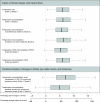Warming increases the risk of civil war in Africa
- PMID: 19934048
- PMCID: PMC2781059
- DOI: 10.1073/pnas.0907998106
Warming increases the risk of civil war in Africa
Abstract
Armed conflict within nations has had disastrous humanitarian consequences throughout much of the world. Here we undertake the first comprehensive examination of the potential impact of global climate change on armed conflict in sub-Saharan Africa. We find strong historical linkages between civil war and temperature in Africa, with warmer years leading to significant increases in the likelihood of war. When combined with climate model projections of future temperature trends, this historical response to temperature suggests a roughly 54% increase in armed conflict incidence by 2030, or an additional 393,000 battle deaths if future wars are as deadly as recent wars. Our results suggest an urgent need to reform African governments' and foreign aid donors' policies to deal with rising temperatures.
Conflict of interest statement
The authors declare no conflicts of interest.
Figures


Comment in
-
Climate robustly linked to African civil war.Proc Natl Acad Sci U S A. 2010 Dec 21;107(51):E185; author reply E186-7. doi: 10.1073/pnas.1014879107. Epub 2010 Nov 30. Proc Natl Acad Sci U S A. 2010. PMID: 21118990 Free PMC article. No abstract available.
-
Concealing agreements over climate-conflict results.Proc Natl Acad Sci U S A. 2014 Feb 11;111(6):E636. doi: 10.1073/pnas.1323773111. Epub 2014 Jan 15. Proc Natl Acad Sci U S A. 2014. PMID: 24429351 Free PMC article. No abstract available.
-
Reconciling disagreement over climate-conflict results in Africa.Proc Natl Acad Sci U S A. 2014 Feb 11;111(6):2100-3. doi: 10.1073/pnas.1316006111. Epub 2014 Jan 13. Proc Natl Acad Sci U S A. 2014. PMID: 24520173 Free PMC article.
Similar articles
-
Climate robustly linked to African civil war.Proc Natl Acad Sci U S A. 2010 Dec 21;107(51):E185; author reply E186-7. doi: 10.1073/pnas.1014879107. Epub 2010 Nov 30. Proc Natl Acad Sci U S A. 2010. PMID: 21118990 Free PMC article. No abstract available.
-
HIV Incidence Prior to, during, and after Violent Conflict in 36 Sub-Saharan African Nations, 1990-2012: An Ecological Study.PLoS One. 2015 Nov 12;10(11):e0142343. doi: 10.1371/journal.pone.0142343. eCollection 2015. PLoS One. 2015. PMID: 26562434 Free PMC article.
-
Impact of long-term civil disorders and wars on the trajectory of HIV epidemics in sub-Saharan Africa.SAHARA J. 2004 Aug;1(2):114-27. doi: 10.1080/17290376.2004.9724834. SAHARA J. 2004. PMID: 17601017
-
Children and war.J Paediatr Child Health. 2003 Apr;39(3):166-72. doi: 10.1046/j.1440-1754.2003.00124.x. J Paediatr Child Health. 2003. PMID: 12654137 Review.
-
Does infectious disease cause global variation in the frequency of intrastate armed conflict and civil war?Biol Rev Camb Philos Soc. 2010 Aug;85(3):669-83. doi: 10.1111/j.1469-185X.2010.00133.x. Epub 2010 Apr 1. Biol Rev Camb Philos Soc. 2010. PMID: 20377573 Review.
Cited by
-
The climate missing: identifying bodies and preventing disappearances linked to climate change.BMJ Glob Health. 2024 Feb 22;9(2):e014767. doi: 10.1136/bmjgh-2023-014767. BMJ Glob Health. 2024. PMID: 38388161 Free PMC article. No abstract available.
-
Beyond the social cost of carbon: Negative emission technologies as a means for biophysically setting the price of carbon.Ambio. 2020 Sep;49(9):1567-1580. doi: 10.1007/s13280-019-01301-y. Epub 2019 Dec 9. Ambio. 2020. PMID: 31820259 Free PMC article.
-
Intergroup conflict: origins, dynamics and consequences across taxa.Philos Trans R Soc Lond B Biol Sci. 2022 May 23;377(1851):20210134. doi: 10.1098/rstb.2021.0134. Epub 2022 Apr 4. Philos Trans R Soc Lond B Biol Sci. 2022. PMID: 35369751 Free PMC article.
-
The Impact of Climate-Change-Related Disasters on Africa's Economic Growth, Agriculture, and Conflicts: Can Humanitarian Aid and Food Assistance Offset the Damage?Int J Environ Res Public Health. 2022 Jan 1;19(1):467. doi: 10.3390/ijerph19010467. Int J Environ Res Public Health. 2022. PMID: 35010724 Free PMC article.
-
Climate change risks for African agriculture.Proc Natl Acad Sci U S A. 2011 Mar 15;108(11):4313-5. doi: 10.1073/pnas.1015078108. Epub 2011 Feb 28. Proc Natl Acad Sci U S A. 2011. PMID: 21368199 Free PMC article.
References
-
- Blattman C, Miguel E. Civil war. J Econ Lit. 2009 in press.
-
- Miguel E, Satyanath S, Sergenti E. Economic shocks and civil conflict: An instrumental variables approach. J Polit Econ. 2004;112:725–753.
-
- Lobell DB, et al. Prioritizing climate change adaptation needs for food security in 2030. Science. 2008;319:607–610. - PubMed
-
- Nicholls RJ, Hoozemans FMJ, Marchand M. Increasing flood risk and wetland losses due to global sea-level rise: Regional and global analyses. Global Environ Change. 1999;9:S69–S87.
-
- CNA Corp. National Security and the Threat of Climate Change. Alexandria, VA: CNA Corp; 2007.
Publication types
MeSH terms
LinkOut - more resources
Full Text Sources

